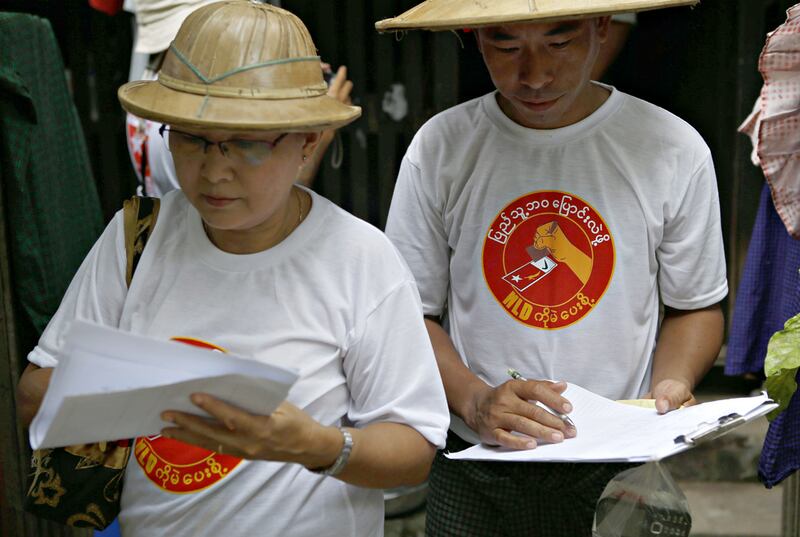YANGON // Fighting peacocks, bamboo hats and lions are just some of the colourful symbols Myanmar’s political parties are using to woo voters in what is, for many, their first free election.
Decades of military rule have smothered debate and left the public disconnected from the dozens of parties who want to represent them as the country makes its transition to democracy.
So as campaigning officially begins Tuesday for the November 8 polls, politicians are turning to pictures, buzzwords and personalities to mark themselves out.
“A picture means more than 100 words,” said Sai Sam Phoon Seng, a campaign officer for the Shan Nationalities League for Democracy (SNLD).
The SNLD is one of around 90 parties registered to take part in the election.
Like political strategists all over the world, Sai Sam Phoon Seng knows the importance of brand-building for a party whose leader was jailed under junta rule and is now preparing to contest its first general election in 25 years.
A symbol can catch “the eyes of the public”, he said at a four-storey house in Yangon, as volunteers cut out stickers emblazoned with a roaring tiger head.
The SNLD is hoping the symbol will mark it out in the cluttered electoral landscape, which includes Aung San Suu Kyi’s opposition grouping.
Despite relatively high levels of literacy, the run-up to the vote has been notable for the absence of any debate on hard policy or detail.
Critical thinking could not flourish under the toxic atmosphere of paranoia and repression encouraged by the former junta.
“It’s a transitional election. Big issues are at stake — democracy or not, reform or not. It’s not the type of election you’d expect to see deep policy discussion,” said Yangon-based Jorge Valladares from the International Institute for Democracy and Electoral Assistance.
But for some observers, the focus on symbols at the expense of substantive debate in this campaign risks leaving voters short-changed.
Maung Zarni, a Myanmar analyst based in Britain, is concerned the elections could prove a wasted opportunity to educate a public long-starved of electoral debate.
“In some places people won’t even know the name of the candidate [when they vote] but this is also driving unhappiness among more informed voters who want to know about policy,” he said.
For the country’s main opposition, the National League for Democracy (NLD), symbols do not come more powerful than its leader Suu Kyi, who spent 15 years under house arrest for her political beliefs.
Images of the democracy icon adorn everything from badges to fans at the fund-raising shop outside the party headquarters in north-east Yangon.
But with around double the number of political parties registering for this election compared to the last, symbols are crowding for space on the campaign trail.
While the SNLD, locally known as the Tiger Head Party, is confident its distinctive logo would never be confused with that of its main rival — the prowling white tiger of the Shan Nationalities for Democratic Party (SNDP) — others have expressed concerns that voters could end up bamboozled.
“At least half a dozen parties are using the fighting peacock symbol,” said Khin Zaw Win of the Tampadipa Institute, a Yangon-based political think tank, referring to the emblem adopted by the NLD ahead of the 2012 by-elections which swept Ms Suu Kyi into parliament.
“They’re entitled to use it and some may want the link [to the NLD]. [But] that means a lot of confusion,” he added.
The peacock symbol harks back to student protests of 1988 which gave rise to the NLD, but the bird has also been adopted by rivals from the other end of the political spectrum.
Symbols have even caused spats.
The most famous was in 2010 when NLD members accused breakaway party the National Democratic Force (NDF) of stealing their bamboo hat — an emblem used by Ms Suu Kyi’s party during its landslide victory in the 1990 elections, which were later annulled by the ruling junta.
Five years on NDF chairman Khin Maung Swe still defends his use of the hat, a motif used to connect with farmers in Myanmar’s largely agrarian economy.
“It was not stealing as others said. The NLD used it only once in the 1990 election and it’s not related to them since that,” he said.
* Agence France-Presse





